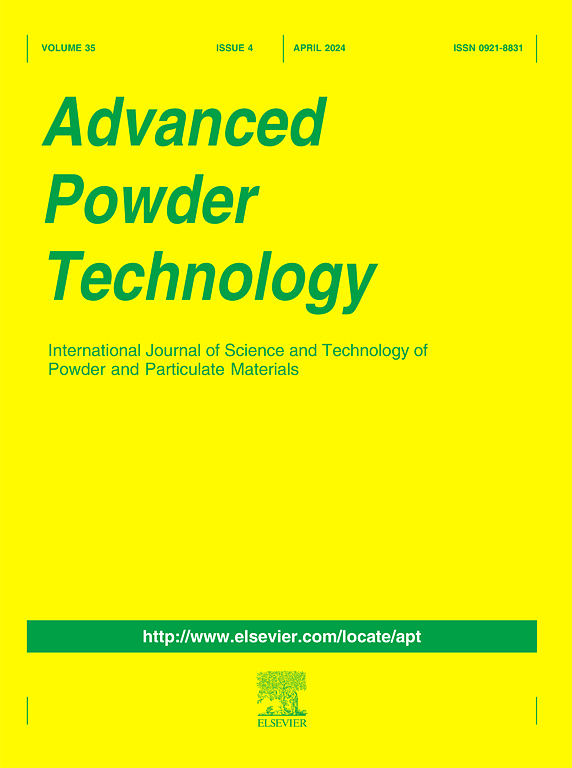用铁基配位聚合物形成的高能复合材料调节高氯酸铵热分解的研究
IF 4.2
2区 工程技术
Q2 ENGINEERING, CHEMICAL
引用次数: 0
摘要
本研究的重点是利用 XRD、XPS 等技术对 Fe5B/AP 纳米颗粒实现的 AP 热分解调节行为进行表征。当 Fe5B 催化剂与 AP 的质量比为 3:1 时,与 AP 分解相关的高温峰明显提前了 181 ℃,导致放热过程更加集中。此外,在低压条件下,Fe5B 与 AP 的最佳质量比为 1:3 时,固体推进剂的燃烧速度比 Fe2O3 高,燃烧速率提高了 10%。在 3.0 兆帕至 9.0 兆帕的压力范围内,含有 Fe5B/AP (1:3)的固体推进剂的燃烧速率与 Fe2O3 保持相似,但压力指数较低。机理研究表明,铁基结构单元和活性金属中心可作为电子转移的中间体,在 LTD 过程中加速 ClO4- 和 NH4+ 之间的电子转移。Fe5B/AP 颗粒在原位生成铁氧化物,促进了氧物种的吸附,增加了 HTD 阶段的热量释放。这些发现凸显了 Fe5B/AP 通过控制高氯酸铵的分解行为而作为固体推进剂燃烧催化剂的应用潜力。本文章由计算机程序翻译,如有差异,请以英文原文为准。

Study on the regulation of thermal decomposition of ammonium perchlorate by energetic composites formed with Fe-based coordination polymers
This study focuses on the thermal decomposition regulation behavior of AP achieved by Fe5B/AP nanoparticles, which are characterized using XRD, XPS and other techniques. When the mass ratio of Fe5B catalyst to AP was 3: 1, the high-temperature peak associated with AP decomposition advanced significantly by 181 ℃, resulting in a more concentrated exothermic process. Additionally, solid propellant containing an optimal mass ratio of 1: 3 for Fe5B to AP exhibited higher burning velocity compared to Fe2O3 under low pressure condition with a 10 % increase in burning rate. Within the pressure range from 3.0 MPa to 9.0 MPa, the combustion rate of solid propellant containing Fe5B/AP (1: 3) remained similar to that achieved with Fe2O3 but displayed a lower pressure index. The mechanistic studies show Fe-based structural units and active metal centers served as intermediates for electron transfer,expediting electron transfer between ClO4- and NH4+ in the LTD process. Fe5B/AP particles generate iron oxides in situ, facilitating the adsorption of oxygen species and promoting increased heat release during the HTD stage. These findings highlight the potential application of Fe5B/AP as combustion catalysts for solid propellants by enabling controlled decomposition behavior of ammonium perchlorate.
求助全文
通过发布文献求助,成功后即可免费获取论文全文。
去求助
来源期刊

Advanced Powder Technology
工程技术-工程:化工
CiteScore
9.50
自引率
7.70%
发文量
424
审稿时长
55 days
期刊介绍:
The aim of Advanced Powder Technology is to meet the demand for an international journal that integrates all aspects of science and technology research on powder and particulate materials. The journal fulfills this purpose by publishing original research papers, rapid communications, reviews, and translated articles by prominent researchers worldwide.
The editorial work of Advanced Powder Technology, which was founded as the International Journal of the Society of Powder Technology, Japan, is now shared by distinguished board members, who operate in a unique framework designed to respond to the increasing global demand for articles on not only powder and particles, but also on various materials produced from them.
Advanced Powder Technology covers various areas, but a discussion of powder and particles is required in articles. Topics include: Production of powder and particulate materials in gases and liquids(nanoparticles, fine ceramics, pharmaceuticals, novel functional materials, etc.); Aerosol and colloidal processing; Powder and particle characterization; Dynamics and phenomena; Calculation and simulation (CFD, DEM, Monte Carlo method, population balance, etc.); Measurement and control of powder processes; Particle modification; Comminution; Powder handling and operations (storage, transport, granulation, separation, fluidization, etc.)
 求助内容:
求助内容: 应助结果提醒方式:
应助结果提醒方式:


